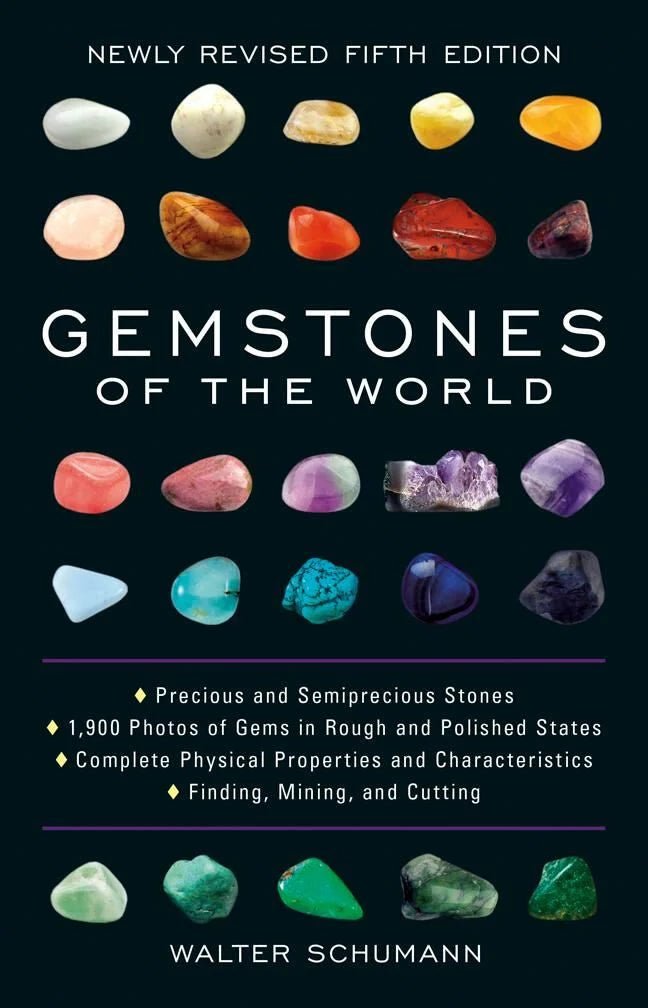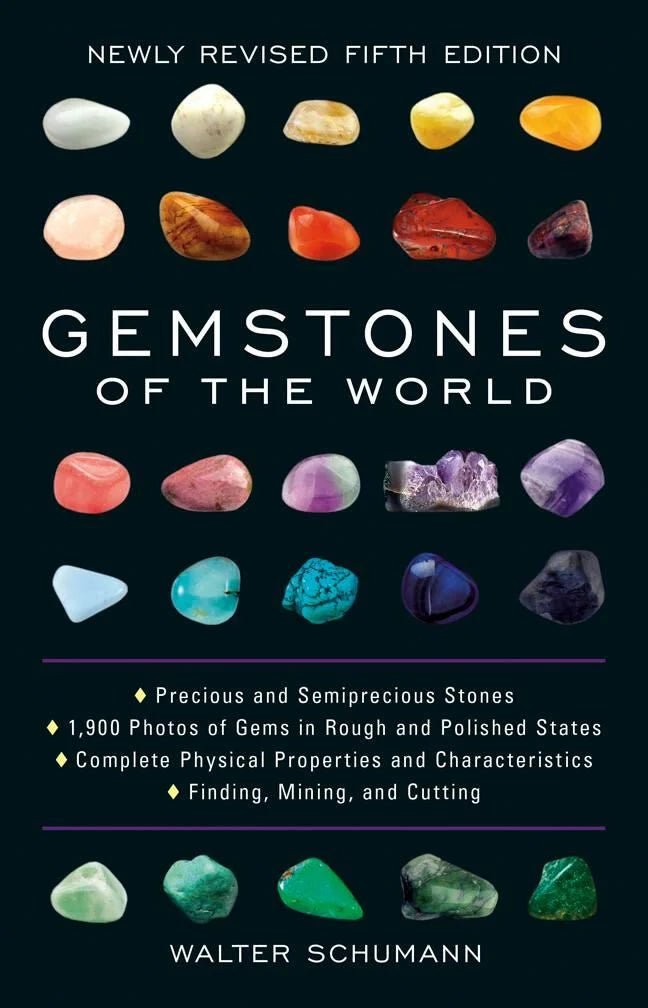
Schumann, Walter: Gemstones of the World
Newly Revised Fifth Edition.
Truly the ultimate one-volume book every hobbyist, jeweler, jewelry maker, and rockhound will ever need! Chock-full of more than 1,500 full-color photos showcasing each precious and semiprecious stone in both its rough and polished state, this bestselling reference book from leading geology expert Walter Schumann will be your go-to identification guide.
Following the spectacular success of the first four editions of Gemstones of the World, the revised fifth edition exhibits important updates and a beautiful new cover. All the gemstones ever discovered are treated here in their many variations. More than 1,500 full-color photos showcase each precious and semiprecious stone in both its rough natural state and its polished and cut renditions. Each entry offers complete information on a stone's formation and structure; physical properties and characteristics; and methods of working, cutting, and polishing.
You'll find full treatments of lesser-known gems and minerals-from andalusite to vesuvianite-and a special section devoted to rocks as precious stones, including alabaster, onyx, obsidian, and fossils. Organic gem materials such as coral, ivory, amber, and pearl are also covered, along with more recently discovered stones like charoite. Additionally, this all-inclusive rocks and minerals book includes imitations, synthetics, and combined stones. Charts and tables help you identify unknown gemstones and-when you're in the market-how to check for authenticity.
Whether you're a beginner rock enthusiast or geologist, or are looking for a crystal book to support your spirituality practice, Gemstones of the World will bring new beauty and wisdom to your bookshelf.
Following the spectacular success of the first four editions of Gemstones of the World, the revised fifth edition exhibits important updates and a beautiful new cover. All the gemstones ever discovered are treated here in their many variations. More than 1,500 full-color photos showcase each precious and semiprecious stone in both its rough natural state and its polished and cut renditions. Each entry offers complete information on a stone's formation and structure; physical properties and characteristics; and methods of working, cutting, and polishing.
You'll find full treatments of lesser-known gems and minerals-from andalusite to vesuvianite-and a special section devoted to rocks as precious stones, including alabaster, onyx, obsidian, and fossils. Organic gem materials such as coral, ivory, amber, and pearl are also covered, along with more recently discovered stones like charoite. Additionally, this all-inclusive rocks and minerals book includes imitations, synthetics, and combined stones. Charts and tables help you identify unknown gemstones and-when you're in the market-how to check for authenticity.
Whether you're a beginner rock enthusiast or geologist, or are looking for a crystal book to support your spirituality practice, Gemstones of the World will bring new beauty and wisdom to your bookshelf.
Normaler Preis
CHF 30.90
CHF 30.90
Normaler Preis
Sonderpreis
CHF 30.90
CHF 30.90
Sparen
/
Grössentabellen für Schmuck
Armbänder, -spangen, -reifen, -ketten
| Alter | Handgelenkumfang |
|
Neugeborenes |
9 - 12 cm |
|
6 Monate – 3 Jahre |
12 - 14 cm |
|
4 - 10 Jahre |
14 - 15 cm |
|
Teenager, Damen (XS) |
15 - 16 cm |
|
Damen (M) |
16 - 17 cm |
|
Damen (XL) |
18 - 19 cm |
|
Herren (M) |
18 - 20 cm |
|
Herren (XL) |
21 - 22 cm |
Kurze Anleitung zum Messen der Handgelenkgrösse:
Wickle ein Massband oder eine Schnur locker um das Handgelenk, an der Stelle, an der das Armband sitzen soll. Achte darauf, dass es eng anliegt, aber nicht einschneidet. Lies den Umfang direkt vom Massband ab oder miss die Länge der Schnur mit einem Lineal.
Hinweis:
Die Länge des Armbandes darf je nach Geschmack 1 cm bis 3 cm länger sein als der gemessene Handgelenkumfang.
Die Länge des Armbandes darf je nach Geschmack 1 cm bis 3 cm länger sein als der gemessene Handgelenkumfang.
Fingerringe
| Ringgrösse | Innendurchmesser | Innenumfang |
|
48 |
15,3 mm |
48 mm |
|
50 |
15,9 mm |
50 mm |
|
52 |
16,6 mm |
52 mm |
|
54 |
17,2 mm |
54 mm |
|
56 |
17,8 mm |
56 mm |
|
58 |
18,5 mm |
58 mm |
|
60 |
19,1 mm |
60 mm |
|
62 |
19,7 mm |
62 mm |
|
64 |
20,4 mm |
64 mm |
|
66 |
21,0 mm |
66 mm |
Kurze Anleitung zum Messen der Ringgrösse:
Methode 1: Innendurchmesser eines passenden Rings messen
- Nimm einen Ring, der gut passt.
- Lege ihn auf ein Lineal und miss den Innendurchmesser (von einer Innenkante zur anderen).
- Vergleiche den Durchmesser mit der Tabelle, um die Ringgröße zu ermitteln.
Methode 2: Fingerumfang messen
- Nimm einen dünnen Streifen Papier oder einen Faden.
- Wickle ihn um die Stelle des Fingers, an der der Ring sitzen soll (nicht zu eng).
- Markiere die Stelle, an der sich die Enden treffen.
- Messe die Länge des Streifens in Millimetern. Das ist der Innenumfang.
- Finde die passende Grösse in der Tabelle.
Tipps:
- Miss die Fingergrösse am Abend, da Finger im Laufe des Tages leicht anschwellen.
- Wenn du zwischen zwei Grössen liegst, wähle die größere Grösse.
- Achte darauf, dass der Ring über den Knöchel passt.


